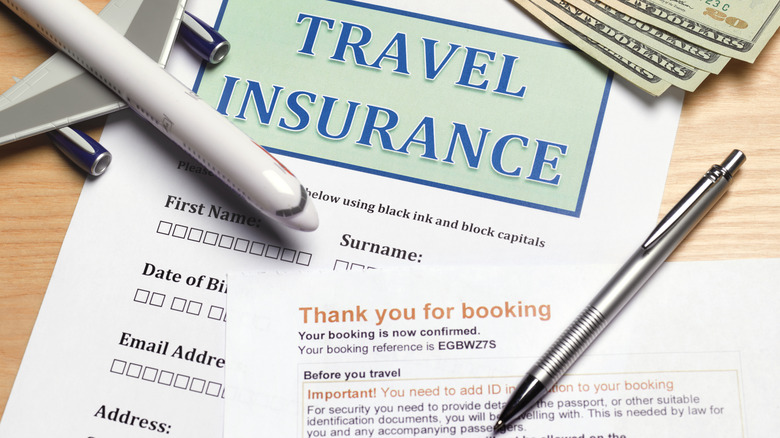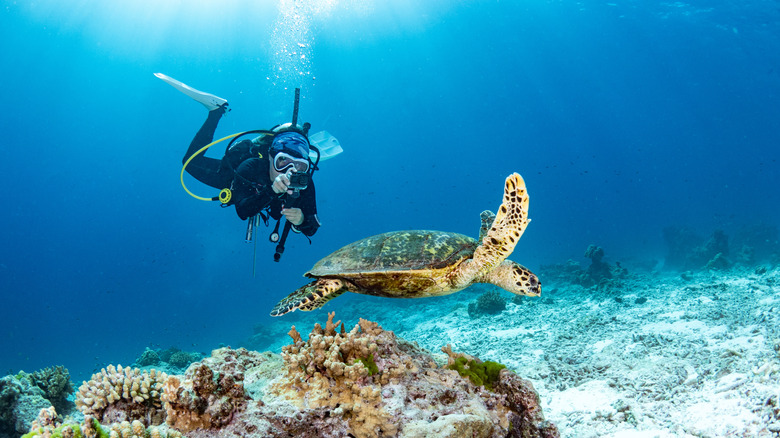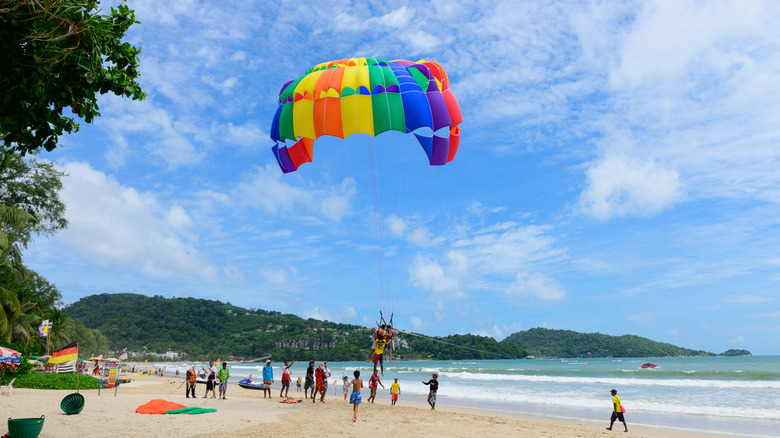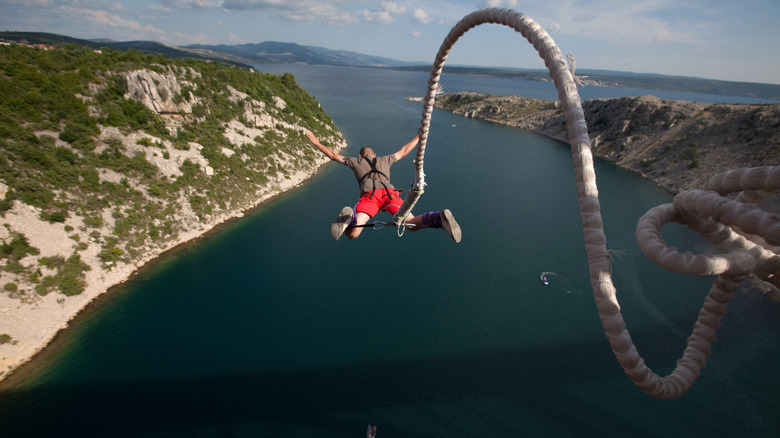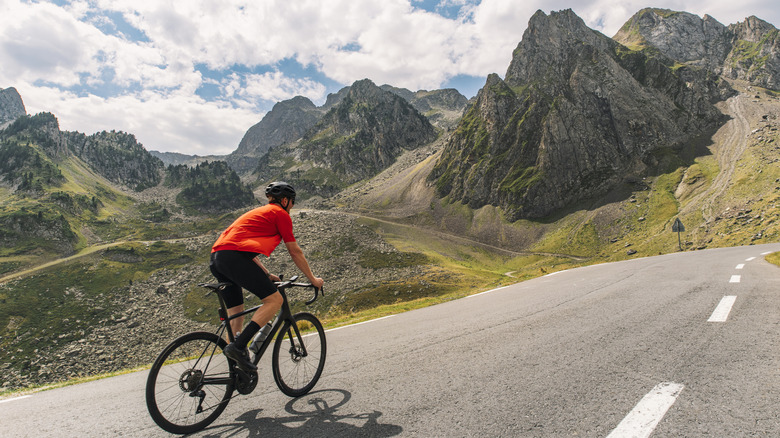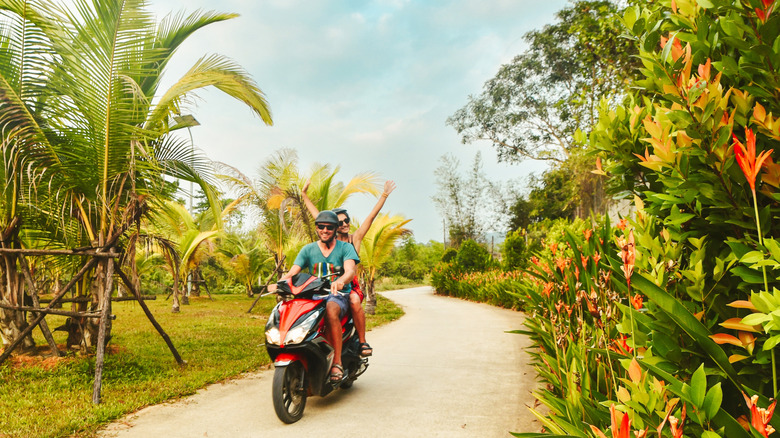The Popular Tourist Activities That Can Actually Void Your Travel Insurance
For many of us, travel is a great joy. However, despite the thrill of packing your bags and being on the move, it also carries some risk, which is why purchasing travel insurance is essential. After all, we've all heard the horror stories. Whether through theft, illness, injury, natural disaster, or other misfortune, some uninsured travelers suddenly find themselves in sticky situations very far from home without a lifeline. This can be inconvenient, stressful, and also very, very expensive.
So yes, insurance is a must anytime you're leaving the borders of your country. That said, make sure to shop around for a policy that caters to your particular needs, and most importantly: Read the fine print. While travel insurance policies are there to take care of you when things go bad, they also have certain exceptions. For example, most will not cover any pre-existing medical conditions, traveling against government advice, or having your valuables stolen after leaving them unattended.
This also goes for some common tourist activities. While you may be tempted to jump on a motorbike in Thailand or snorkel around a beautiful coral reef in French Polynesia, if something goes wrong you could find yourself holding the bag. Insurance companies can void your insurance if you take part in any endeavor that they exclude from coverage for being too hazardous, such as the following activities.
Scuba diving and snorkeling
While many people head to the tropics for white sand, palm trees, and sun-kissed bliss, the chance to take in the kaleidoscopic array of underwater sea life is also a chief attraction, especially at picture-perfect beaches in places like Honduras. Snorkeling and scuba diving are the best ways to experience this magical marine world. However, you still need to make sure that your policy covers them because many do not.
If a standard policy does cover scuba diving, it will surely come with depth restrictions (33 to 131 feet is common) and will also require you to be certified with a recognized diving organization, such as the Professional Association of Diving Instructors (PADI), the National Association of Underwater Instructors (NAUI), or Scuba Schools International (SSI). If not, you must be in the company of a certified instructor. The policy may also dictate just what type of diving you can do. For example, riskier activities such as cave or wreck diving may be excluded. So, it's important to know before you go.
The good news is that if you plan to do a lot of underwater exploration, you can usually purchase add-ons to give you the coverage you need. There are also insurance policies that exclusively cover snorkeling and diving, which may be appropriate for multi-day trips –– especially if you're bringing your own gear.
Parasailing
Let's say you're lounging on one of Cancún's gorgeous beaches, reading a book while the cooling Caribbean breeze blows through your hair. You've reached that place of perfect tropical relaxation when suddenly something catches your eye: a parachute soaring above the turquoise waters like a multi-colored bird. Towed by a boat on the surface of the sea, a single human in the harness beneath the chute takes in the idyllic scene below from hundreds of feet in the air.
It all looks so exhilarating, and while you may be tempted to jump out of your lounge chair and sign up for the next ride, you should also know that parasailing is not included in most standard travel insurance policies. Like any other vacation activity that involves extra danger, you can usually only get parasailing coverage by shelling out extra for a hazardous sports rider. You also need to consider whether it's worth it. After all, how many rides are you really going to do during one trip?
Bungee-jumping
Bungee-jumping traces its roots to Pentecost Island in the South Pacific nation of Vanuatu, where young men would jump from a tower with a vine tied to their legs in a rite-of-passage ritual called "Nagol," which means "land diving." While islanders still practice the ceremony, a group of Western thrill-seekers adapted the ritual into the extreme sport we know today. The first commercial bungee-jumping site was opened at Kawarau Bridge in New Zealand in 1988, and bungee-jumping has since spread all over the globe, offered at iconic spots such as Africa's awe-inducing Victoria Falls and China's Macau Tower. It's surely one of the most thrilling things a human being can do, but not without risk –– however slight it may be.
According to Best Health Degrees, bungee-jumping clocks in with one death per 500,000 jumps. This makes it far safer statistically than, say, canoeing, hiking, or even driving a car. This means that a lot of companies will cover one or even three jumps when done under correct (meaning licensed) supervision. However, other insurance carriers still view it as a hazardous activity, so you may have to pay a bit more for that extra peace of mind while plunging earthwards with a rubber band strapped to your ankle.
Banana Boating
Another waterborne activity that may or may not be covered by travel insurance is banana boating. Invented in the 1980s, these inflatable water sleds hold three to 10 people who hang on for dear life while a speedboat pulls them along the water's surface at heart-racing velocities. It may not be as extreme as bungee jumping off a massive waterfall, but it doesn't come without dangers.
You'll find banana boats at almost any beach, drawing crowds for fun and recreation everywhere from pristine beaches in the Philippines to high-end Caribbean resorts with their white sands and party-like atmospheres. While seeming like good, family fun, banana boats also come with hidden dangers. The point of the ride is to hang on while the boat driver attempts to throw you into the water by making sharp weaves and turns. Sure, it's thrilling, but according to one study (via the National Library of Medicine), this can also lead to life-threatening neurovascular injuries. Many travel insurance policies do cover banana boat rides, while others do not. The question is, even if the activity isn't excluded, do you really want to take the risk?
Bicycling
One of the best ways to explore a new spot — like Japan's ancient capital of Kyoto — is by jumping on two wheels and peddling away. Not only do bicycles offer the freedom to move around easily and quickly, but they're also a terrific form of exercise. Is there any better way to earn that big dinner or a couple of satisfying beers than by spending the day cruising around under your own muscle power?
Injuries suffered while cycling are generally covered by most any travel insurance policy, but only if they fall under the category of "leisure cycling." This also goes for theft, unless your bike gets swiped while being left unattended without a proper lock. Then, you're probably out of luck. Serious cyclists may need to take out extra insurance, as multi-day bike trips, touring, races, and mountain biking are often not included in general policies.
Another thing to keep in mind is that insurers will only reimburse you for the cost of medical treatment for injuries if you were wearing a helmet at the time of the accident. This goes for almost any vacation activity: You are only covered if you use all of the proper safety equipment, so you should rent a helmet if you're not bringing your own.
Skiing and snowboarding
While some choose to escape winter's grip by heading to warm locales like South American destinations that make for an ideal Christmas vacation, others embrace the cold by strapping on a pair of skis and hitting the slopes. The United States offers plenty of opportunities to plow down a mountainside through perfect powder, and overseas spots such as the Alps in Europe or Japan's rugged northern island of Hokkaido also draw plenty of winter sports enthusiasts for their ideal conditions and value.
It should come as no surprise that skiing and snowboarding are usually not covered by standard travel insurance policies. As fun as they are, both activities are considered high-risk. This is especially true for inexperienced skiers and snowboarders who may not be as adept at stopping or guiding themselves down the mountain. Skiing and snowboarding are, in fact, among the most dangerous things you can do on vacation, so plan accordingly. This means purchasing a policy or add-on that will cover you in case of an avalanche or accidental collision with a tree.
Motorbike riding
It's a no-brainer that jumping on a motorbike is among the riskiest things you can do while traveling, but that doesn't stop countless travelers from rolling the dice, especially while visiting enchanting environs of Southeast Asia –– where mopeds, scooters, and motorcycles are widely available to rent for cheap.
It's tempting to pay for a motorbike, as riding one isn't just fun and exhilarating. It also allows you to explore whole cities, towns, and regions without being beholden to any schedule but your own. That said, accidents are far too common, leading to horrific injuries or even death. According to the Bangkok Post, 15,000 people die on motorbikes in Thailand each year, accounting for 74% of all road deaths.
Given these sobering statistics, it's surprising that many travel insurance policies actually do cover riding a motorbike, but with certain provisos, such as engine size (125cc is the max for many). If you're planning to zip around on a bike during your next vacation, make sure to have your papers in order, including a valid license, since many carriers won't insure you otherwise. Your claim will also be denied if you are found to have broken the laws of the road, including riding under the influence of drugs and alcohol. Wearing a helmet is also a must. For general safety, make sure to dress appropriately as well. Always wear long pants — preferably jeans or leather — in addition to appropriate footwear. This means leaving your flip-flops at the guesthouse.
